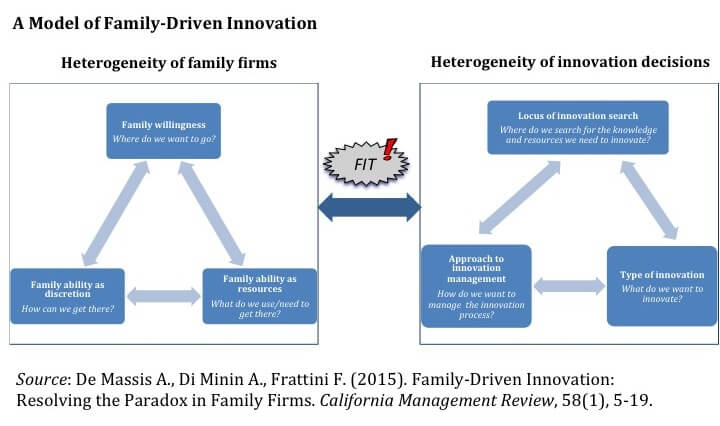
It is no secret that family businesses are wrongly perceived as being more conservative and traditional than non-family enterprises, which in turn makes them less innovative. However, research shows that though it is true that family businesses are oftentimes more conservative, they have an inherent ability to innovate more than their competitors. The question then becomes, how can family businesses not only overcome this perception but also actively drive innovation in their firms?
How can family businesses actively drive innovation?
In this interview with Tharawat Magazine, Alfredo De Massis, Professor of Entrepreneurship & Family Business at Lancaster University Management School, explains the concept of Family-Driven Innovation.
What is the paradox of innovation that family businesses face?
In order to understand this paradox characterizing family business innovation, it is important to consider two key drivers of family governance that cause the differences in behavior and performance between family and nonfamily firms as well as among family firms: ability and willingness.
By ability, I mean the family owners’ discretion to direct, allocate, add to, or dispose of a firm’s resources; by contrast, willingness refers to the favorable disposition of the involved family to engage in a distinctive behavior. It encompasses the goals, intentions, and motivations that drive the family involved to influence the firm’s behavior in directions that are different from those pursued by firms without family involvement.
Due to their distinctive characteristics, family businesses are considered to be less willing to innovate than nonfamily firms while being more able to do so. This creates a paradox, which is manifested by family firms innovating less despite having the ability to do more.
Put differently, family firms, owing to the virtually unfettered ability of family owners and the involvement of family managers, have superior ability to innovate compared with their nonfamily competitors. However, owing to their unique set of economic and noneconomic goals, family owners are typically willing to engage in idiosyncratic strategies, which in many cases means they innovate less rather than more. This greater ability that family owners are believed to have in combination with family firms’ lower willingness to innovate constitutes a paradox that locks the innovation potential of these firms.
What is Family-Driven Innovation?
Family-Driven Innovationii refers to the internally consistent set of strategic decisions that allow a family firm to resolve the innovation paradox by ensuring a close fit between these decisions and the characteristics of the family firm.
It is a new perspective in innovation management and applying this perspective means that family business owners and executives should, in a first step, consider the internal consistency between the key contingency factors that identify the characteristics of family firms and capture their heterogeneity, as well as the internal consistency between the key contingency factors that capture the heterogeneity of innovation decisions. Then, they need to take into account the fit between the contingencies of heterogeneity of innovation decisions and the contingencies of heterogeneity of family firms.
Finally, they should recognize that when there is a misfit between innovations decisions and family firm characteristics, creating a competitive advantage through innovation in family firms is unlikely. Conversely, if innovation decisions match the characteristics of the family firm, then Family-Driven Innovation is possible and can lead to the creation of competitive advantage through innovation.
It’s important to note that Family-Driven Innovation can be successfully implemented in any family business, regardless of its size or industry. For example, Azienda Agricola Cirinnà Vincenzo is a small-sized, third generation family business operating in the organic olive oil industry and located in Sicily that was extremely capable of realizing Family-Driven Innovation, thereby building sustainable competitive advantage through innovation across generations.
What are some factors that can help family firms identify their own characteristics and help them innovate?
Three contingency factors describe the characteristics of family firms and capture their heterogeneity. They are the WHERE, HOW, and WHAT of family firms that capture, respectively, the direction where the family firm wants to go (as expressed by the family owners’ goals and intentions, i.e., their “willingness” to behave), the discretion the family firm has to move in that direction (which is a function of the structures, governance mechanisms, and decision-making processes that constrain the power of family owners, i.e., what we call “ability as discretion”), and the resources and capabilities that are needed or should be used for family owners to lead the firm toward that direction (what we call “ability as resources” ).
Similarly, strategic decisions in innovation can be mapped along the same WHERE, HOW, and WHAT contingency factors, which means deciding where the firm will find the knowledge resources it needs to innovate (e.g., within its existing knowledge base, in new knowledge domains, or searching over time), how the innovation process is managed (e.g., whether the firm follows an open or closed approach to innovation), and what the firm wants to innovate (e.g., whether it will prioritize products/services, processes, or business model innovation and whether more emphasis will be given to radical or incremental innovation).
As I said, you can unlock the innovation potential of family firms only if you are able to achieve a close fit between the contingencies of heterogeneity of family firms and the contingencies of heterogeneity of innovation decisions. This means making Family-Driven Innovation happen.
What would you say to family firms who are content with their traditional approach and unwilling to take the drastic steps needed to innovate?
My main recommendation would be to avoid resting on their laurels. If on one hand, the long-lasting and intimate links that families in business are able to build with their traditions can lead to a competitive advantage of family firms over their nonfamily counterparts, it is also important to keep firmly in mind that innovation is a major determinant of firms’ competitive advantage and performance. So innovation should be a strategic imperative for any family business throughout its lifecycle. It would be a big mistake to stop paying attention to innovation for the sake of protecting tradition.
I think that tradition and innovation should not be seen as two opposite aspects in a trade-off relationship; conversely, family businesses should find ways to be innovative while still preserving their tradition.
This is in line with my most recent research showing that some family businesses can be extremely innovative while remaining firmly anchored to their past and tradition. In other words, some highly innovative family firms are capable of actually leveraging their tradition to innovate – that is having “innovation through tradition”.iii
What advice do you have for family firms who want to unlock their potential and gain the competitive edge through innovation?
As I explained before, to unlock the potential for innovation in family firms a close fit is required between the heterogeneity of innovation decisions and the heterogeneity of the family firm’s idiosyncratic characteristics. We call this internally consistent set of strategic decisions Family-Driven Innovation.
Business executives and scholars should take an integrated perspective to determine the contingencies of the WHERE, HOW and WHAT that capture the heterogeneity of innovation decisions and those capturing the heterogeneity of family firms, as well as taking into account the fit between these two sets of contingencies as a key mechanism through which family involvement in a business organization can lead competitive advantage through innovation. Achieving this fit can often lead family firms to avoid the standard best practices that are typically prescribed by innovation management handbooks if these do not match their distinctive characteristics.
In this vein, a research that I recently conducted to investigate the design decisions that fit family firm characteristics and innovation decisions to create high-performing new product development programs revealed three design principles concerning teams, leadership, and incentives that diverge from customary approaches of organizing for new product development.iv
In sum:
- Family firms should recognize the crucial role of innovation
- in family business and not undervalue innovation’s potential
- to ensure the competitive advantage of the family firm across generations
- Family-Driven Innovation is a possible way to resolve the ability and willingness paradox in family business innovation and unlock their innovation potential
- Family firms should avoid using some traditional best practice
for innovation if they do not leverage their distinctive resources - Consultants should advise family firms to adopt some best practices
for innovation management, but only when they fit the distinctive characteristics of the family firm.
[i] For further details on the ability and willingness paradox see Chrisman, J. J., Chua, J. H., De Massis, A., Frattini, F., & Wright, M. (2015). The ability and willingness paradox in family firm innovation. Journal of Product Innovation Management, 32(3), 310-318.
[ii] For further details see De Massis A., Di Minin A., & Frattini F. (2015). Family-driven innovation: Resolving the paradox in family firms. California Management Review, 58(1), 5-19.
[iii] For details see De Massis, A., Frattini, F., Kotlar, J., Messeni-Petruzzelli, A., Wright M. (2016). Innovation through tradition: Lessons from innovative family businesses and directions for future research. Academy of Management Perspectives, In press
[iv]For details see De Massis, A., Kotlar, J., Frattini, F., Chrisman, J., Nordqvist, M. (2016). Family governance at work: Organizing for new product development in family SMEs. Family Business Review, in press.










